Learning styles are one of the most debatable concepts in American education. They represent a pillar that supports the educational industry.
Moreover:
Many teachers and caregivers believe that learning styles are inborn and define how successful the child will be in their future career and personal life.

- What’s the use of understanding your learning style?
- What are the key objections to the concept?
- Are learning styles a myth?
This article explains the difference between learning styles and learning preferences. To get more insights about education, refer to our custom writing company.
Go on reading and decide which suits you best!
📈 The Evolution of Learning Styles
A learning style is an individual’s method of understanding and memorizing new information. We usually do this through sight, touch, and sound. Other senses, such as taste and smell, are less efficient than these three. Still, they are highly efficient combined with them, helping solidify our memories.
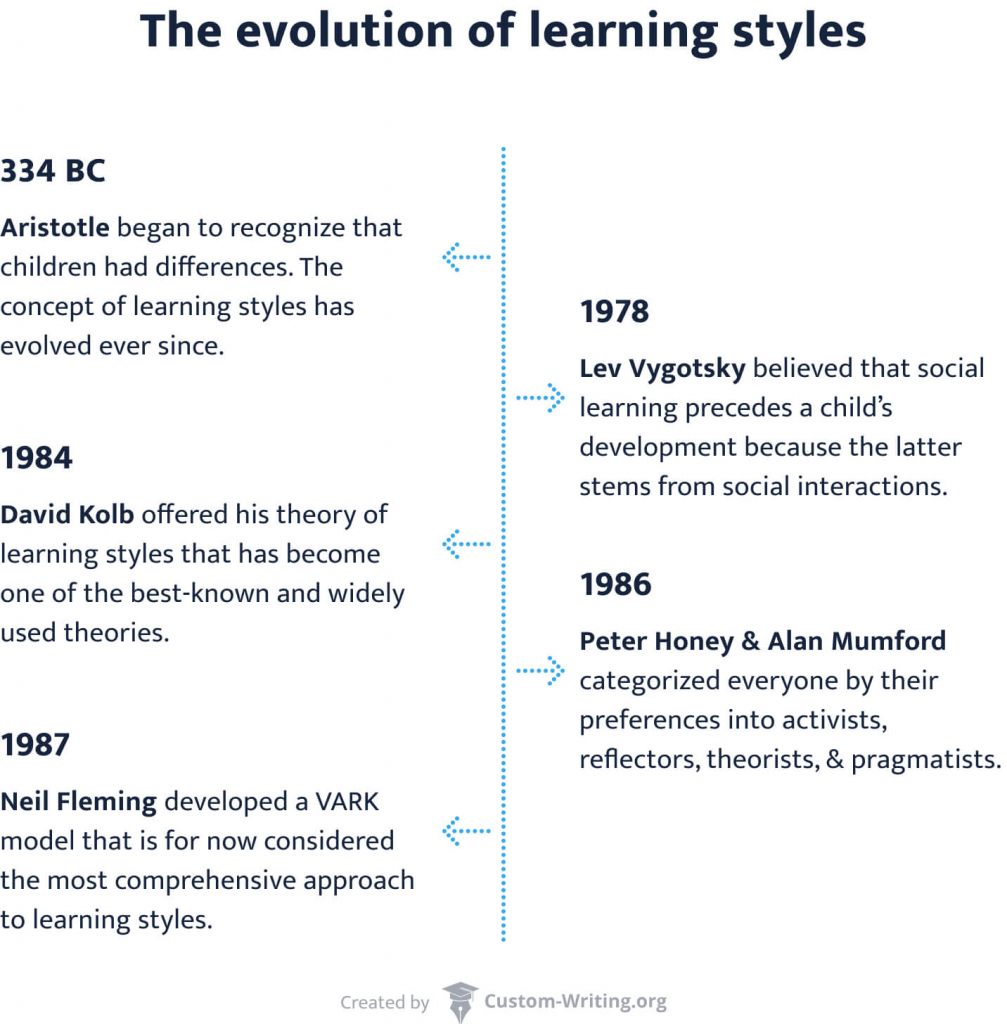
The idea that we all have a specific learning style appeared in 334 BC when Aristotle hypothesized that each child possesses specific talents and skills. Various learning models were based on his observations.
David Kolb’s model was invented in 1984. It divided all people into 4 categories:
Peter Honey and Alan Mumford’s model adapted David Kolb’s version of Aristotle’s observation. The model categorizes everyone into 4 categories by their experiences and preferences rather than their innate qualities:
- Activists
- Reflectors
- Theorists
- Pragmatists
Walter Burke Barbe proposed three modalities abbreviated as VAK:
- Visual
- Auditory
- Kinesthetic (tactile)
Later, Neil Fleming developed a VARK model, expanding Barbe’s findings. The VARK model is the subject of this article since it is the most comprehensive approach to learning styles to date.
🙋 The VARK Learning Styles
Understanding how our brain processes information can accelerate our education. It makes daily learning easier. Moreover, reviewing the material before an exam becomes more effective and rewarding when you understand your learning style.
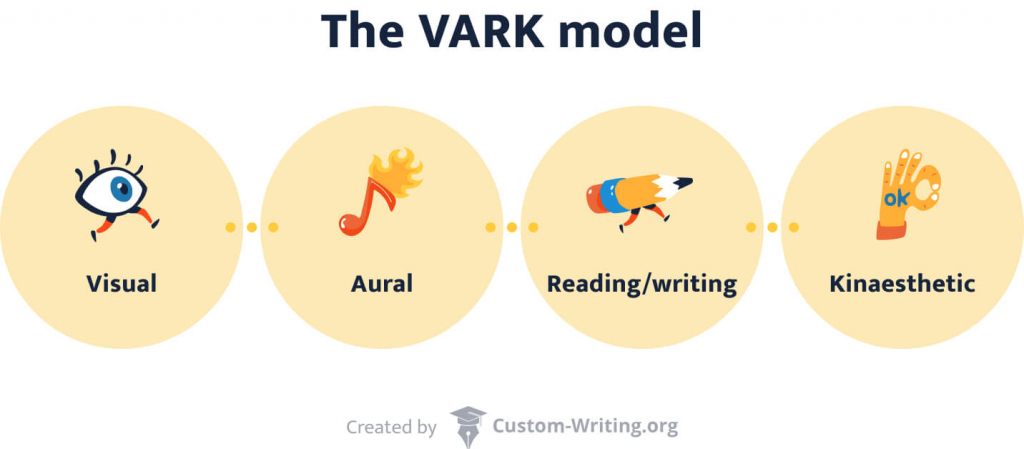
In 1987, an educational theorist called Neil Fleming created the VARK learning styles model. The acronym stands for Visual, Auditory, Reading, and Kinesthetic, which are the most habitual ways for an individual to learn things. Fleming believed that we tend to prefer one or two of the styles, and with time, we can master all of them.
Visual Learning
You’re a visual learner if you need an explicit reference each time you memorize some material. It means you retain information by seeing it. You usually pay much attention to small detail (e.g., how people are dressed or their body language). You are also likely to imagine situations in order to process theoretical information while reading it.
Auditory Learning
Most fans of audiobooks are auditory learners. They prefer to listen to others rather than actively engage in class. For example, it is easier for them to memorize a written text if they read it out loud. Most auditory learners report that loud or background noise deteriorates their memorizing ability.
Reading/Writing Learning
If you have the most colorful and detailed notes in your class, you are most likely a reading and writing learner. You take in new information best when it is displayed in words. You also like to read into definitions and make summaries.
Kinesthetic Learning
Tactile learners memorize information best by doing things (and touching objects). They usually use the trial-and-error approach in whatever they are doing. They thrive in practical subjects like arts, technology, and sports. A good idea for them would be to intermingle brief bursts of studying with intensive physical activity.
❌ Learning Styles Misconceptions
In 2019, the American Psychological Association conducted an online query of 668 participants. Shockingly, 90% of teachers and caretakers believed every child’s learning style would define their entire life and career.
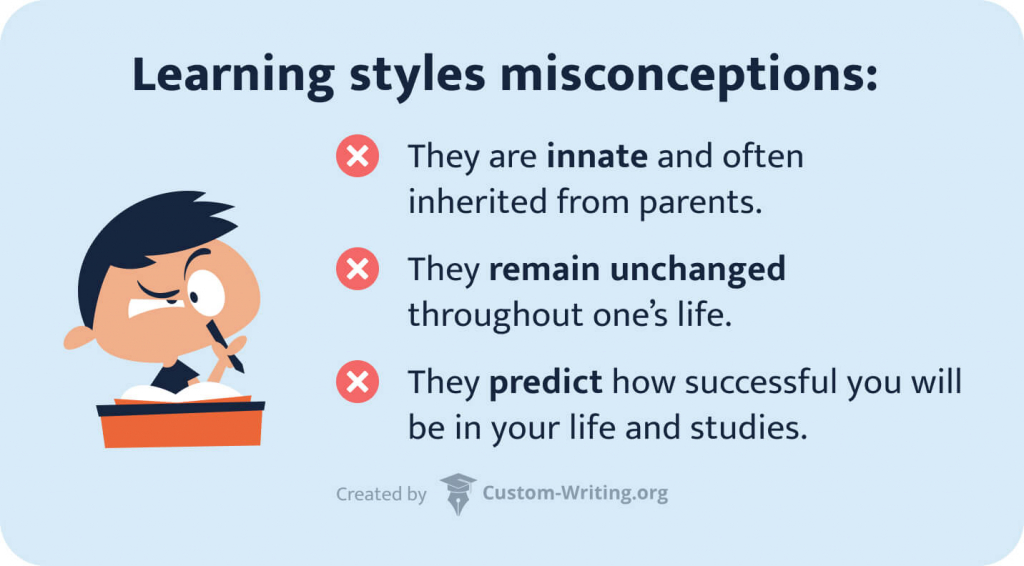
The researchers split the group who believed in learning styles into “essentialists” and “nonessentialists.” The latter have a vague understanding of the concept and don’t pay much attention to it.
But essentialists have a firm idea of learning styles, which includes the following beliefs:
- A learning style is innate (and often inherited from parents).
- Learning styles remain unchanged over the course of life.
- Learning styles predict how successful you will be in your career and life.
The most disappointing part is listed below:
- There is no scientific reasoning behind the idea of learning styles.
- The “essentialists” group is represented mainly by preschool and primary school teachers.
- Race, gender, income rate, and occupation did not affect how strongly a person believes in this pseudo-scientific theory.
- Many parents and educators unnecessarily waste their time and money on services and products geared toward learning styles.
Are Learning Styles a Myth?
The learning styles approach has dominated the education field. However, there is a lack of trustworthy research confirming the efficiency of utilizing learning styles. In 2009, a group of psychology experts reviewed the existing scientific evidence on the issue.
They found that all the publications are built on the premise of questionnaires that ask questions such as, “How do you think you better perceive information?” The research focused on how people perceive themselves, which is notoriously subjective. There is no hard evidence that learning styles affect our lives in any way.
If someone wants to prove that learning styles exist, they must conduct an experiment with the following strict criteria:
- Students should be grouped by their learning style.
- Students from each group should randomly receive instruction according to various methods.
- All the students should take the same final test.
- Finally, the experiment should reveal a correlation between a learning style and the instructional method. In simpler terms, students with the best results must have matched their learning style and the instruction type, and vice versa.
🆚 Learning Styles Vs. Learning Preferences
Research says it is unlikely that inborn learning styles exist or that they persist throughout our lives. But does that mean the theory is of no use?
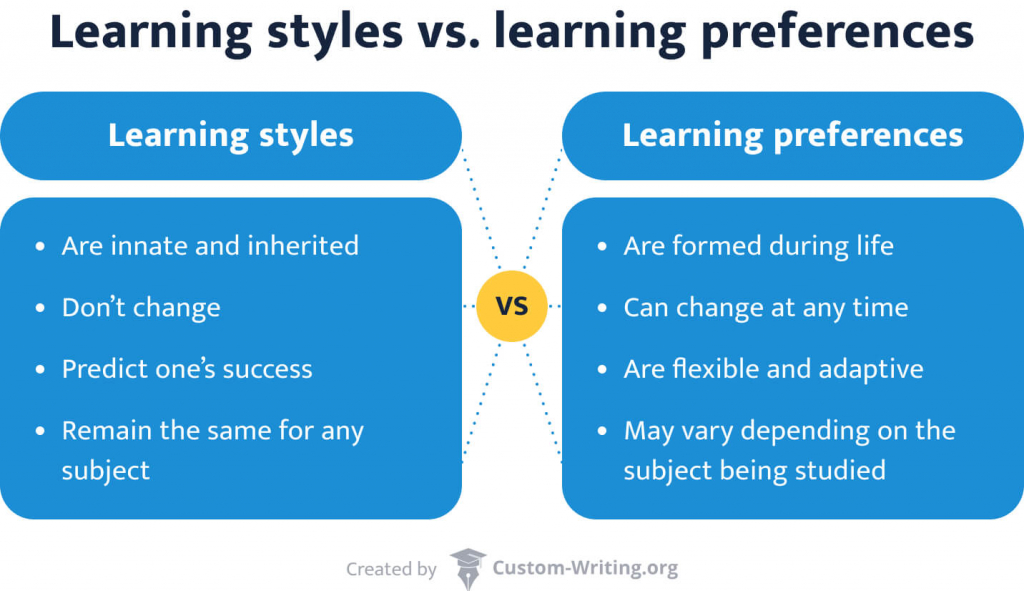
Let’s consider what does exist to resolve the controversy.
The Ability to Perceive Various Types of Information
Some people have physical conditions that lower their chances of using a particular learning skill:
- Hearing disorders prevent people from having a “listening learning preference.”
- Students with dyslexia don’t use reading as their preferred learning approach.
- Blindness or color blindness will make it difficult to learn visually.
- Limitations on fine motor skills impair the efficiency of hands-on learning activities.
As you can see, everything is relative. Sometimes our choice is objectively limited. But the fact that a specific skill is inaccessible does not mean that the person in question has an inborn “learning style.”
Learning Preferences Change over Time
Imagine you enjoy vacuuming but hate mopping the floors. But if you only vacuum your floor, you will never get out of the stains.
So:
You decide that the time has come to try another approach, and you grab the mop.
You can procrastinate with tasks you struggle with, but at some point, you will set your hands on them. And more likely than not, you will learn much more from those challenging tasks. We all need to take a reasonable step outside our comfort zone to grow.
The Specific Requirements of a Studied Discipline
Let’s return to our vacuuming and mopping example. If you spill milk and your vacuum cleaner can’t clean liquids, you will have to use a mop anyway. We need specific tools to attain our desired results. You cannot learn to ride a bicycle only by watching videos of others practicing the sport, no matter how great of a “visual learner” you are.
Here’s another example. You’re assigned to learn a poem by heart. Will you use pictures to draw every image the poet created or read the poem as many times as possible, no matter which method you prefer?
Are Learning Styles a Myth?
Current research in psychology suggests they are. Still, having a diverse educational approach is crucial since it ensures a whole world of new possibilities. We have just one piece of advice: don’t get stuck on learning styles. Consider them to be learning preferences that you can adjust according to your needs.
🎓 14 Study Methods for Various Learning Preferences
We’ve agreed that there are no learning styles, but there are learning preferences.
Let’s now look at how you can use that information.
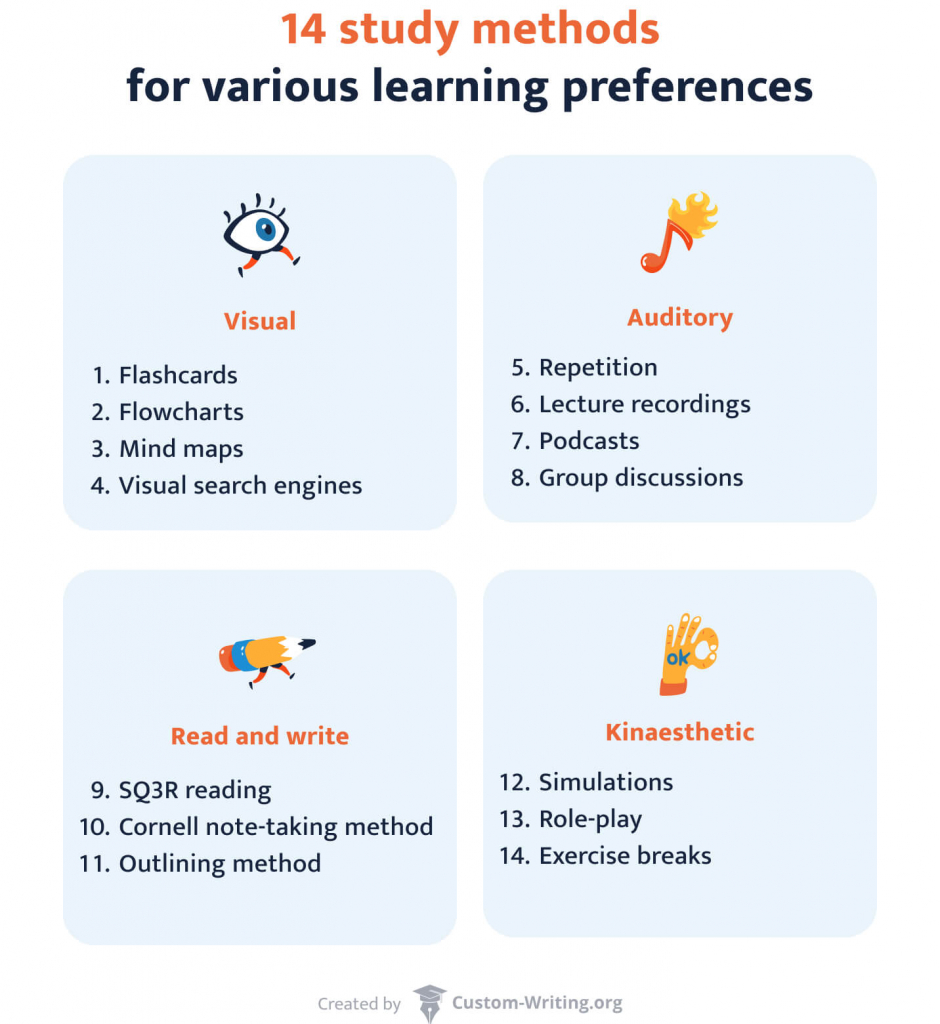
We’ve explained the most efficient memorization activities for students with any of the four learning preferences.
Visual Learning Methods
Visual learning methods are intended for people who prefer to process images rather than reading text.
They apply to everything related to: spelling and grammar, graphic design, painting, photography, spatial thinking (geometry, architecture, and engineering), and graphs & charts (data science and strategic planning).
Here’s a brief list of learning methods that can be helpful in these disciplines.
Flashcards
Flashcards are rectangular pieces of paper or cardboard with information on both sides. As a rule, students use them to memorize information. They usually have a term, fact, or exam question written on one side and an explanation on the other. Some prefer making digital flashcards. But the principle remains the same.
Flashcards have been helping students with self-testing since the 1900s. The act of writing on cards and physically flipping them over engages multiple parts of your brain. Moreover, the learning method indicates the gaps in your memory, revealing what you need to study more in-depth. But most importantly, using flashcards strengthens your visual association of the term or question with the correct answer.
Flowcharts
If you prefer flowcharts rather than flashcards, this section is for you. Flashcards fail to provide a general overview of a topic since the pieces are disjointed. You can still put them out on the table and draw connections, but tidying up removes the links forever.
Flowcharts are a fantastic tool to trace connections between concepts and events. They are commonplace in research because they are indispensable when your topic branches out in various directions.
They are equally applicable both in theoretical and practical courses. In the former, you trace the evolution of ideas and theories. In the latter, you follow the sequence of actions in a particular case.
Our advice here is to focus on the most critical details and use as few words as possible. Otherwise, your flowchart risks turning into an impenetrable mess.
Mind Maps
When you have pages and pages of information but can’t understand the topic, try using mind maps. This method improves memory, shows the relationship between different facts and ideas, enhances creativity, and boosts your problem-solving skills.
Mind maps are a perfect alternative to conventional note-taking lists with titles. An efficient mind map shapes the topic, draws the relative importance of separate points, and demonstrates their relationships.
This method is very similar to a flow chart. The only difference is that flowcharts proceed linearly from top to bottom, and mind maps are drawn clockwise from the top. Like in a childish drawing, they resemble a sun or a flower with a central node and branching radial structures.
The effectiveness of mind maps is confirmed by research, particularly for dealing with complex data, like business planning and strategy development.
Visual Search Engine
When you use Google to search for a topic and feel overwhelmed by the bulk of text-based information, try a visual search engine.
What’s so different about it?
It searches for images and video materials. And though you might require a text-based search engine at a later stage of your research, these are an excellent place to start for the visual learner.
- Google Images. It browses all the graphic files available online. You can even upload a reference image to find similar ones.
- Flickr. That’s an excellent alternative to Google Images since it provides access to high-resolution professional photographs.
Auditory Learning Methods
Mastering these methods can be fruitful since you can use them while doing another activity, such as walking, cooking, or tidying your place.
Auditory learning methods are applicable to psychology, interpretation, journalism, music, sound engineering, sales, teaching, HR, history, and literature. Any spoken presentation will do, but we’ve grouped some of the most efficient approaches here.
Repetition
This technique may seem too obvious to consider, but you should remember that practice makes perfect.
Repetition is a crucial learning method since it transfers knowledge from the conscious to a deeper level. The most satisfying “aha” moments result from a repeated encounter with the same information at a different moment under different circumstances.
Deliberate reiteration of such encounters cements the knowledge in your memory.
And even more so:
- It builds confidence.
- It turns actions into habits.
- It lowers stress and boosts your focus.
- It increases predictability.
- It doubles your learning speed.
Lecture Recordings
Another straightforward idea. If you prefer listening to watching, record the lectures you attend. This approach has two benefits:
- You can focus on what the lecturer says rather than on how to put it into words in your notes.
- You can listen to the lectures again and again.
You will find the technique helpful for such disciplines as literature, history, and psychology – in a word, all humanities that don’t require visual support.
Podcasts
Podcasts are an effortless learning technique. You can use them anywhere and pause them whenever necessary.
Here are another 6 reasons to use them in your studies:
- They don’t require continuous Wi-Fi access.
- They help you catch up if you’ve missed several days or weeks of classes, which in turn lowers your academic-related stress.
- They are better than watching material or reading because your mind cannot wander off (or you will miss the whole idea).
- Listening to related podcasts before the lesson will make you more engaged in the classroom.
- They are quick to find on any topic and are free or very cheap.
- They can accommodate other learning preferences by making notes (yes, as if you attend a lecture), creating flow charts, or recording your own podcasts.
There are millions of themed podcasts online, but we suggest checking the following examples:
Group Discussions
Group discussions are an excellent educational tool. They boost your listening skills and improve your public speaking confidence. According to research, students memorize up to 70% of information by talking about it and as much as 95% by explaining it to others.
Among other valuable benefits of group discussions, we’ve listed the following:
- GD trains your problem-solving skills. They bring together people with diverse (and often opposing) opinions. This method teaches you to use healthy communication strategies to find common ground with others.
- GD makes you open-minded. While listening to other opinions, you learn to appreciate how different we are.
- GD, in fact-intense subjects (like history), makes memorizing raw data more exciting.
If the above points inspire you, learn how to organize functional discussion groups.
Read & Write Learning Techniques
A traditional approach to education presupposes that everyone enjoys reading and writing. Funny as it may sound, this is true for many of us. That’s why we won’t focus on reading and writing per se but rather look at some highly productive learning techniques.
SQ3R Reading
SQ3R is a tool to get more information from the first reading.
The acronym stands for:
- Survey. Read the topic outline, fact boxes, and glossary to get a general idea of the topic. This way, you’ll feel more at ease with the more complicated passages. A nice bonus is that surveying the text before reading can pique your interest in the topic and its details.
- Question. Turn headings into questions before you read. You will thank yourself during the future exam for doing so in advance. Also, anticipate what the text will discuss and ask yourself what you expect to learn from it.
- Read. Read to find answers to the questions you’ve made at the previous stage. This will keep you focused and make the entire process more rewarding. Note everything you don’t understand to explore in the referenced materials later on.
- Recite. Identify the central points and take a look at how other facts are connected to them. Once you’ve done this, return to the questions you made at stage 2, and answer them from memory. Don’t look up the information in the text unless you cannot remember.
- Review. Reread all your notes to see if you have a thorough understanding of the material. Then, schedule regular reviews to keep the information fresh in your mind.
Cornell Note-Taking Method
The Cornell method is great because it leaves you with nice and neat notes that are perfectly readable after the lecture. Moreover, try it once, and you’ll be surprised at how much of the class you remember. And unlike traditional noting methods, this one is interactive (you are supposed to leave spaces to summarize your notes later).
That’s how the process goes:
- Divide your page into two columns.
- Use the left for cue questions, and the right for main notes.
- Write the title of the lecture at the top of the page.
- Make a summary at the bottom.
Notes taken according to the Cornell method are handy for self-testing. You already have the questions. Just close the right column, and there’s your test with pre-made questions.
Outlining Method
Unless you study physics or math, the outlining method might suit your memorization needs.
The most general information starts at the very left margin.
- Each specific group of facts is noted with indented spaces to the right.
- Demonstrate the relationships between the multi-level parts by indenting them.
- Do not waste your processing memory on numbers or letters.
Just like that. This entire section is an example of the outlining method.
Kinesthetic Learning Techniques
These techniques are designed for those who easily recall things when they’ve done them by themselves at least once.
The applicable disciplines here comprise whatever is done by hand (or body): applied arts, cooking, engineering, dentistry, surgery, sports, and dances. Here are a couple of examples for you to try.
Simulations
Simulations place you in situations where you can practically apply your classroom knowledge. Did you know that in healthcare, simulations have been on the curricula since the 18th century? They’ve helped midwives and obstetricians to-be learn how to manage childbirth complications.
Technology has made an immense leap since then. Still, simulation remains a safe reproduction of reality to train people to behave in stressful or critical situations.
The technique can be split into two subtypes:
Role-play
Role-play is another hands-on technique to master new knowledge.
But:
Unlike simulations, it is more practical for humanities, marketing, sales, and other disciplines requiring more eloquence. Role-play lets students explore realistic scenarios of interacting with others in a controlled way. Thus, they build experience to behave accordingly in real-life situations.
Regardless of the sphere, role-playing is when participants are assigned certain roles to play in an interaction. They may receive specific instructions beforehand (regarding the preferable behavior or words). Otherwise, they are supposed to act as they think fit, depending on the exercise.
The participants will act out the scenario. Then, they discuss how efficient, healthy, or comfortable the interaction was. They can also brainstorm alternative ways of managing the case. Based on the reflection and discussion, the plan can be acted out again with respective changes.
Exercise Breaks
These aren’t a learning technique in the word’s conventional meaning, but they are necessary to boost your learning productivity. Exercise breaks are helpful for everyone, especially those with kinesthetic learning preferences.
According to research by Princeton University, working out soothes the stress from the pressure of finals. And being mindful of the fact that our brain operates best in a peaceful and comfortable environment, exercise breaks can improve your learning results.
Another research by McMaster University featuring 75 participants demonstrated that exercise breaks increase attention at lectures. Remember how in primary school, the teacher asked you to move around every 15 minutes? It still works for you!
Thank you for reading this article!
Take your time to find out which learning preferences you have. Think of the last time you prepared for an exam. Which techniques did you employ? Share your learning hacks in the comments below.
🔗 References
- Learning Styles – The Models, Myths and Misconceptions
- 4 Types of Learning Styles: Explaining the VARK Model
- Learning Styles Don’t Actually Exist, Studies Show
- Learning Styles: The Legend, The Myth
- Are ‘Learning Styles’ Real?
- The Learning Styles Myth is Thriving in Higher Education
- Understanding Learning Styles
- SQ3R Reading Method | Academic Success Centers


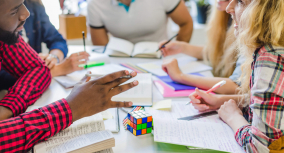
![How to Organize a Successful Study Group [GUIDE]](https://custom-writing.org/blog/wp-content/uploads/2023/04/doing-homework-together-1-284x153.jpg)

![The Scaffolding Technique in Education: Benefits & Examples [Is It Really Useful?]](https://custom-writing.org/blog/wp-content/uploads/2023/03/business-women-signature-document-1-284x153.jpg)





